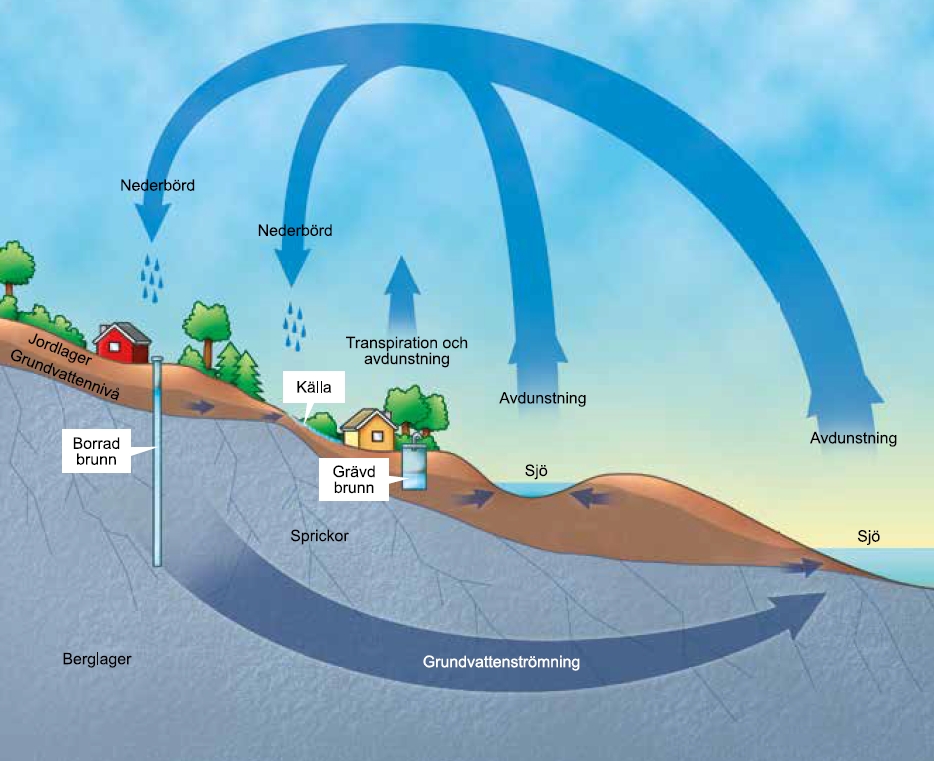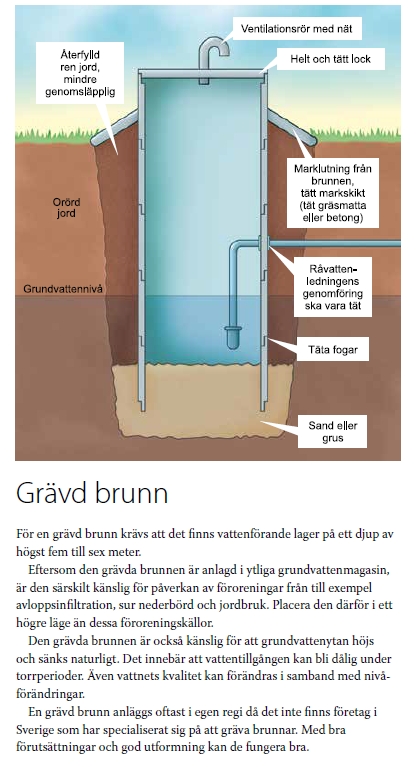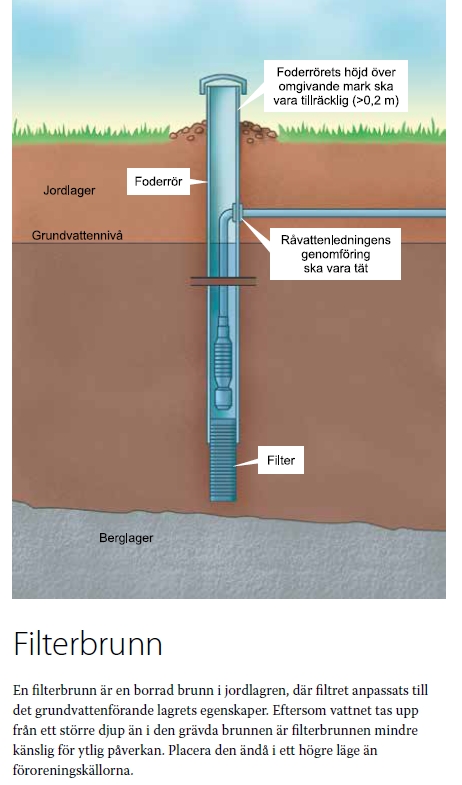Your cart is currently empty!
Building your own well for good drinking water
This brochure is for people who are planning to build their own well. It describes how different wells work and
what you need to know when installing a well. It also gives advice on what to consider when buying the services needed.
Three types of wells
There are three main types of wells. The most common today is the construction of rock drilled wells. But the other types of wells are also common, especially in older properties.
Excavated well
An excavated well requires the presence of aquifers at a depth of no more than five to six meters.
Because the excavated well is constructed in shallow aquifers, it is particularly sensitive to the influence of pollutants from, for example, sewage infiltration, acid rain and agriculture. Therefore, place it at a
higher location than these sources of pollution.
The dug well is also sensitive to the natural rise and fall of the water table. This means that water availability can be poor during dry periods. The quality of the water can also change in connection with changes in level.
An excavated well is usually constructed by the company itself, as there are no companies in Sweden that specialize in digging wells. With good conditions and good design, they can work well.
Filter well
A filter well is a well drilled into the ground, where the filter is adapted to the characteristics of the aquifer. As the water is drawn from a greater depth than in the dug well, the filter well is less sensitive to surface impacts. However, it should be placed at a higher level than the sources of pollution.
Drilled well
Rock drilled wells are usually drilled using so-called down-the-hole drilling, which is driven by compressed air. The method is a combination of rotation and impact. This drilling technique can handle almost all forms of water well drilling regardless of soil conditions. Other techniques depend on specific geological conditions and have different limitations.
Rock drilled wells are usually constructed in two stages: drilling with casing through soil layers and a few meters down into the rock, and pure rock drilling down to water-bearing layers or fractures.
Rock drilled wells are the type of well that is most commonly constructed today. The rock drilled well has great advantages if the work is done carefully and professionally. Therefore, always hire a certified well driller.
The drilling technique makes it easier, among other things, to give the well good protection against external influences. Rock drilled wells are also placed in a higher position than the sources of pollution.
Although the water supply may be small, it is relatively rare for a borehole to provide too little water for an individual household.
Very worth reading!
For advice! Call us 010-490 10 50 or email info@avloppscenter.se
Shop directly as an individual or through your contractor.
0 €
This brochure is for people who are planning to build their own well. It describes how different wells work and
what you need to know when installing a well. It also gives advice on what to consider when buying the services needed.
Three types of wells
There are three main types of wells. The most common today is the construction of rock drilled wells. But the other types of wells are also common, especially in older properties.
Excavated well
An excavated well requires the presence of aquifers at a depth of no more than five to six meters.
Because the excavated well is constructed in shallow aquifers, it is particularly sensitive to the influence of pollutants from, for example, sewage infiltration, acid rain and agriculture. Therefore, place it at a
higher location than these sources of pollution.
The dug well is also sensitive to the natural rise and fall of the water table. This means that water availability can be poor during dry periods. The quality of the water can also change in connection with changes in level.
An excavated well is usually constructed by the company itself, as there are no companies in Sweden that specialize in digging wells. With good conditions and good design, they can work well.
Filter well
A filter well is a well drilled into the ground, where the filter is adapted to the characteristics of the aquifer. As the water is drawn from a greater depth than in the dug well, the filter well is less sensitive to surface impacts. However, it should be placed at a higher level than the sources of pollution.
Drilled well
Rock drilled wells are usually drilled using so-called down-the-hole drilling, which is driven by compressed air. The method is a combination of rotation and impact. This drilling technique can handle almost all forms of water well drilling regardless of soil conditions. Other techniques depend on specific geological conditions and have different limitations.
Rock drilled wells are usually constructed in two stages: drilling with casing through soil layers and a few meters down into the rock, and pure rock drilling down to water-bearing layers or fractures.
Rock drilled wells are the type of well that is most commonly constructed today. The rock drilled well has great advantages if the work is done carefully and professionally. Therefore, always hire a certified well driller.
The drilling technique makes it easier, among other things, to give the well good protection against external influences. Rock drilled wells are also placed in a higher position than the sources of pollution.
Although the water supply may be small, it is relatively rare for a borehole to provide too little water for an individual household.
Very worth reading!
For advice! Call us 010-490 10 50 or email info@avloppscenter.se
Shop directly as an individual or through your contractor.
Product details
No files available.
This brochure is for people who are planning to build their own well. It describes how different wells work and
what you need to know when installing a well. It also gives advice on what to consider when buying the services needed.
Three types of wells
There are three main types of wells. The most common today is the construction of rock drilled wells. But the other types of wells are also common, especially in older properties.
Excavated well
An excavated well requires the presence of aquifers at a depth of no more than five to six meters.
Because the excavated well is constructed in shallow aquifers, it is particularly sensitive to the influence of pollutants from, for example, sewage infiltration, acid rain and agriculture. Therefore, place it at a
higher location than these sources of pollution.
The dug well is also sensitive to the natural rise and fall of the water table. This means that water availability can be poor during dry periods. The quality of the water can also change in connection with changes in level.
An excavated well is usually constructed by the company itself, as there are no companies in Sweden that specialize in digging wells. With good conditions and good design, they can work well.
Filter well
A filter well is a well drilled into the ground, where the filter is adapted to the characteristics of the aquifer. As the water is drawn from a greater depth than in the dug well, the filter well is less sensitive to surface impacts. However, it should be placed at a higher level than the sources of pollution.
Drilled well
Rock drilled wells are usually drilled using so-called down-the-hole drilling, which is driven by compressed air. The method is a combination of rotation and impact. This drilling technique can handle almost all forms of water well drilling regardless of soil conditions. Other techniques depend on specific geological conditions and have different limitations.
Rock drilled wells are usually constructed in two stages: drilling with casing through soil layers and a few meters down into the rock, and pure rock drilling down to water-bearing layers or fractures.
Rock drilled wells are the type of well that is most commonly constructed today. The rock drilled well has great advantages if the work is done carefully and professionally. Therefore, always hire a certified well driller.
The drilling technique makes it easier, among other things, to give the well good protection against external influences. Rock drilled wells are also placed in a higher position than the sources of pollution.
Although the water supply may be small, it is relatively rare for a borehole to provide too little water for an individual household.
Very worth reading!
For advice! Call us 010-490 10 50 or email info@avloppscenter.se
Shop directly as an individual or through your contractor.
No files available.




